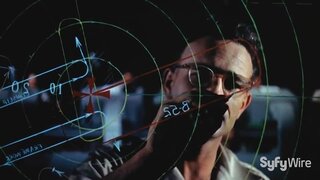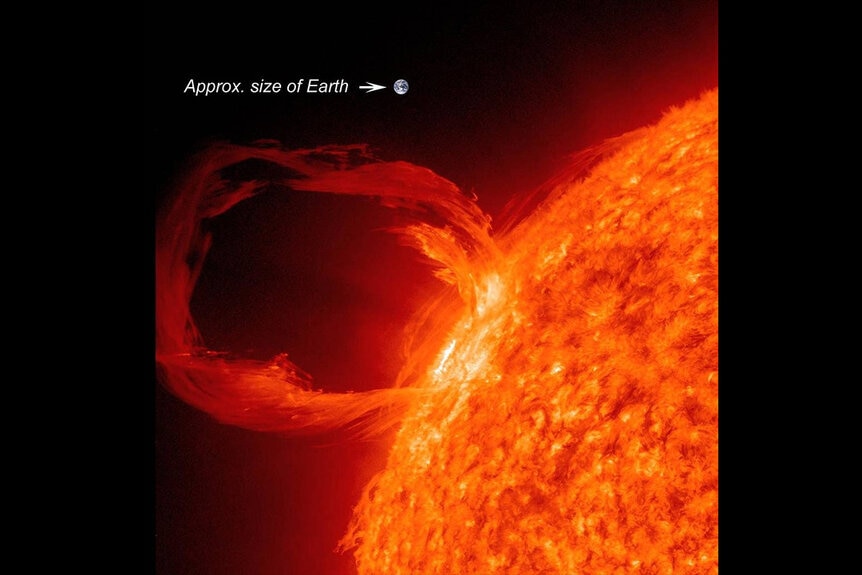Create a free profile to get unlimited access to exclusive videos, sweepstakes, and more!
How the world could end, the science behind 'Knock at the Cabin'
Knock, knock.

In Paul Tremblay’s novel The Cabin at the End of the World, a family on vacation at a remote cabin is visited by four strangers. The visitors each carry a different makeshift weapon and tidings of the impending apocalypse. The family is given a choice: they can sacrifice one of their own and save the entire world or they can refuse, and live long enough to watch reality crumble.
The book got the big screen treatment in M. Night Shyamalan’s Knock at the Cabin (now available on digital and Peacock!). Tremblay, Shyamalan, and the strangers aren’t up front about the nature of the end of the world, only that it is coming, and on a long enough timescale they are right. Wait around long enough and something is bound to come along and wipe our planet of the cosmic map. If nothing else gets around to it, the Sun eventually will. Which got us wondering about the most likely ways the world could end... you know, some light weekend fare.
RELATED: Where and when to stream M. Night Shyamalan's apocalyptic mystery-thriller 'Knock at the Cabin'
CORONAL MASS EJECTION (CME)
Humanity is almost ready to cross asteroid impacts off of the list of potential world enders, but the universe has plenty of other weapons at its disposal. When given the opportunity to spy the Sun from the corner of your eye, you’ve probably noticed a featureless circle of bright light, shining ever downward on the planet’s surface.
For tens of thousands of years, humanity looked up at the Sun and that’s what they saw. The star, filtered through the atmosphere, loses most of its most interesting features. Only when seen from outside of the atmosphere, or with specialized astronomical equipment, can we see its true shape and nature.
Modern telescopes reveal massive explosions of hot plasma erupting from the surface of the Sun. Some of them crash back to the surface like magma bubbling in an unimaginably large volcanic caldera. Others are carried away by the same electromagnetic energy which kicked them loose in the first place, racing across the cosmos.
These events, known as coronal mass ejections, have potentially civilization-crumbling consequences, but only for a civilization like ours. Counterintuitively, this is the sort of apocalypse you can avoid by simply being ill-prepared for it. In 1859, a CME commonly known as the Carrington Event struck the Earth, causing aurora and geomagnetic storms across the planet.
The CME didn’t harm anyone directly, but it did carry enough energy to destroy telegraph equipment and start a few fires. Interestingly, we got off pretty light because we didn’t have a lot of electrical infrastructure in the middle of the 19th century. If the same sort of event were to happen today, the consequences would be much more dire.
If the Carrington Event or something similar happened today, it’s estimated that the electrical grid and communications systems could be knocked offline for months or years. Electricity, heating, cooling, radio, television, the internet, GPS, cell phones, and more, all of the things we’ve come to depend on just to exist in the world, could all vanish in a blink.
As far as apocalypses go, things could be worse. Certainly, the loss of infrastructure would cause incredible damage resulting in an untold number of deaths, but the species would persist. And provided we didn’t eat ourselves, we could get the lights back on.
YELLOWSTONE SUPERVOLCANO
If you live anywhere in the western half of North America, you probably have an at least passing familiarity with the super volcano lurking beneath Yellowstone. Humanity is no stranger to volcanoes, having witnessed an untold number of eruptions, and their devastating consequences, over the course of our history. But we’ve never witnessed anything like this.
If Yellowstone were to pop its top, there isn’t a spot on the planet that wouldn’t feel its touch, according to the United States Geological Survey. In their estimation, a large eruption would cover the surrounding area in several feet of ash, enough to crush houses and snuff out anything living. Those who live further afield wouldn’t feel the effects right away, but they would come.
Ash, sulfur, and other particulates would spew into the atmosphere and be carried to every corner of the globe. Those particulates would block out sunlight for months or years, causing even more die-off of plants and animals. Whether you’re in Wyoming or as far from the Cowboy State as you can get, you’re going to get burned eventually.
Fortunately, recent studies have confirmed little risk of a large eruption happening in the next several thousand years.
GAMMA RAY BURST
While a coronal mass ejection could knock us on our butts, a gamma ray burst (GRB) could put us down forever. GRBs are caused by the collapse of massive stars or the collision of neutron stars or black holes; they are, without contest, the most powerful electromagnetic explosions in the universe. Luckily for us, we keep a good distance from other stars, and most GRBs are a long way off and pointed in another direction.
If one were to strike us from close by, however, we’d be in for a really bad (if brief) time of it. Rather than transform all of humanity and the rest of the life on Earth into green, anger-fueled superheroes, the right kind of GRB would transform us into powerless, irradiated corpses.
A nearby GRB hitting Earth with a directed beam would unleash enough energy to strip the planet’s ozone layer. Immediately, we would be exposed to increased levels of radiation, leading to an increased risk of cancer. Not to mention a spike in the price of sunscreen. More importantly, it would cause chemical reactions in the air, producing toxic ozone at the planet’s surface, which would also lead to respiratory distress and disease. If the beam were powerful enough, long lasting enough, and close enough, we wouldn’t live long enough to worry about cancer or respiratory disease. The radiation could kill everything in its path outright, leaving large swaths of the planet (maybe even the entire planet) completely devoid of life.
What makes them frightening, like the strangers in Knock at the Cabin, is that they are external and out of our control. It’s also what makes them sort of not worth worrying about. The real most likely causes of our own demise — biological or chemical warfare, human-driven environmental collapse, nuclear winter... you get the idea — are subtler and closer to home. The knock, as it turns out, usually comes from inside the cabin.
Knock at the Cabin is now available on digital or streaming on Peacock.





























